No results were found for the filter!
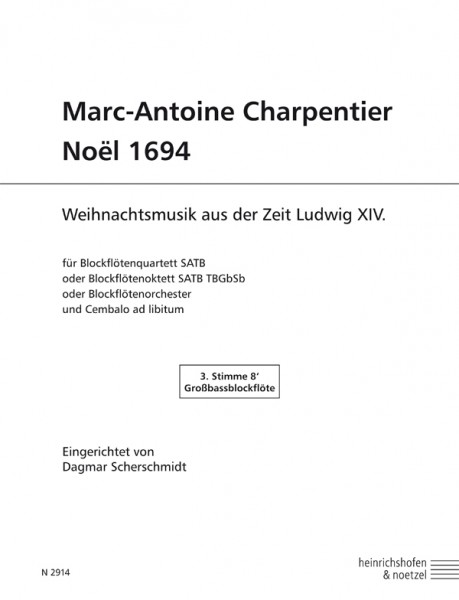
Marc-Antoine Charpentier
Noël 1694 - great bass part Great bass recorder (recorder quartet / octet,...
Nicht nur zur Weihnachtszeit… Marc Antoine Charpentiers instrumentale Noëls bezaubern mit ihren eleganten Tanzsätzen das ganze Jahr über. Dagmar Scherschmidt hat die „Noëls sur les instruments“, die „Noëls pour les instruments“ sowie das „Agnus Dei“ aus der „Messe de Minuit“ zusammengefasst und eingerichtet für Blockflötenquartett SATB, oder Blockflötenoktett SATB TBGbSb, oder Blockflötenorchester, jeweils mit Cembalo ad libitum, wobei besonders durch einen Wechsel von Hochchor und Tiefchor die von Charpentier komponierten Klangfarben eingefangen werden. Erhältlich ist dieses Arrangement mit Musik aus der Zeit Ludwig XIV. in einer Ausgabe für Blockflötenquartett SATB mit Cembalo ad libitum. Einzelstimmen für den Tiefchor (TBGbSb) sind separat erhältlich. Inhalt: - Ou sèn vont ces guays bergers H.534 - Laissez paistre vos bestes H.531 - Vous qui desirez sans fin H.531 - A la venue de Noël H.534 - O Createur H.531 - Les Bourgeois de Chastre H.534 - Joseph est bien mariè H.534 - Or nous dites Marie H.534 - Une jeune pucelle H.534 - A minuit fut fait un resvail H.9
Mehr €5.00 *
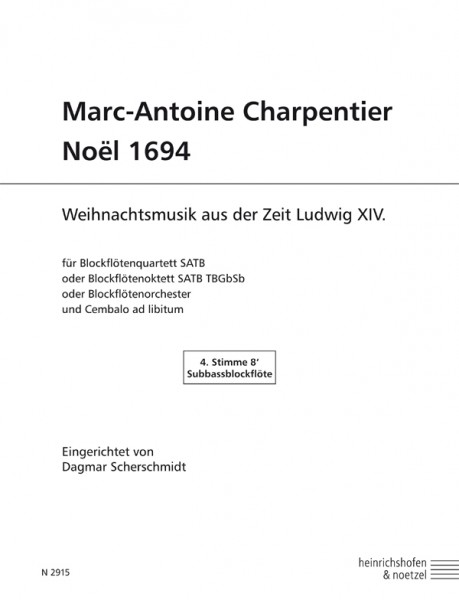
Marc-Antoine Charpentier
Noël 1694 - subbass part Sub bass recorder (recorder quartet / octet, harpsichord...
Not only at Christmas time... Marc Antoine Charpentier's instrumental Noëls enchant with their elegant dance movements all year round. Dagmar Scherschmidt has combined the ‘Noëls sur les instruments’, the ‘Noëls pour les instruments’ and the ‘Agnus Dei’ from the ‘Messe de Minuit’ and arranged them for recorder quartet SATB, or recorder octet SATB TBGbSb, or recorder orchestra, in each case with harpsichord ad libitum, whereby the colours of sound composed by Charpentier are captured in particular through an alternation of high choir and low choir. This arrangement with music from the time of Louis XIV is available in an edition for recorder quartet SATB with harpsichord ad libitum. Individual parts for low choir (TBGbSb) are available separately. Content: - Ou sèn vont ces guays bergers H.534 - Laissez paistre vos bestes H.531 - Vous qui desirez sans fin H.531 - A la venue de Noël H.534 - O Createur H.531 - Les Bourgeois de Chastre H.534 - Joseph est bien mariè H.534 - Or nous dites Marie H.534 - Une jeune pucelle H.534 - A minuit fut fait un resvail H.9
Mehr €5.00 *
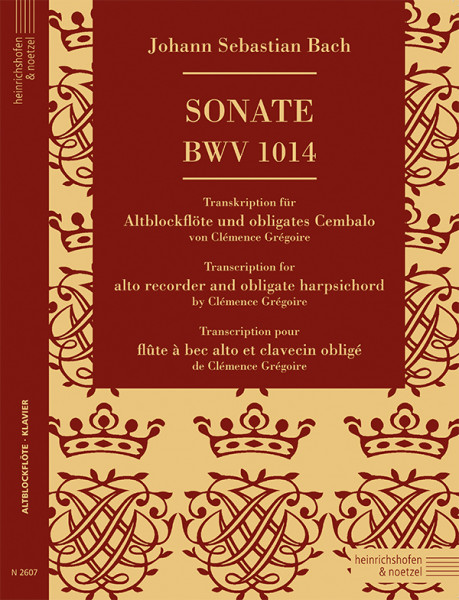
Johann Sebastian Bach
Sonate BWV 1014 Die sechs Sonaten für Violine und Obligato-Cembalo BWV 1014-1019 komponierte Bach vermutlich in seiner Köthener Zeit. Es sind besondere Sonaten, denn sie sind in erster Linie für das Cembalo gedacht, mit Begleitung eines Melodie-Instruments. Nun hat Clémence Grégoire die Sonate BWV 1014 für Altblockflöte und Cembalo eingerichtet und so transkribiert, dass sie perfekt auf die Gegebenheiten der Blockflöte passt.
Mehr €16.00 *

Raphael Benjamin Meyer
Orient-Express Raphael Meyer nimmt 5 Blockflöten und 1 Cembalo mit auf eine unterhaltsame Reise von Wien über Paris nach Konstantinopel auf den Spuren des legendären Orient-Expresses. Abfahrt und Halt des Zuges werden auf den Instrumenten ebenso nachempfunden wie die typischen Eindrücke der Haltepunkte. Ein absolut hinreißendes Stück, das dazu einlädt, auch mal gemeinsam mit einem Blockflötenorchester auf die Reise zu gehen. Inhalt: - Abfahrt / Departure - Wien / Vienna - Paris - Konstantinopel Die Stimmen sind einzeln erhältlich.
Mehr €4.00 *

Raphael Benjamin Meyer
Orient-Express Raphael Meyer nimmt 5 Blockflöten und 1 Cembalo mit auf eine unterhaltsame Reise von Wien über Paris nach Konstantinopel auf den Spuren des legendären Orient-Expresses. Abfahrt und Halt des Zuges werden auf den Instrumenten ebenso nachempfunden wie die typischen Eindrücke der Haltepunkte. Ein absolut hinreißendes Stück, das dazu einlädt, auch mal gemeinsam mit einem Blockflötenorchester auf die Reise zu gehen. Inhalt: - Abfahrt / Departure - Wien / Vienna - Paris - Konstantinopel Die Stimmen sind einzeln erhältlich.
Mehr €4.00 *

Raphael Benjamin Meyer
Orient-Express Raphael Meyer nimmt 5 Blockflöten und 1 Cembalo mit auf eine unterhaltsame Reise von Wien über Paris nach Konstantinopel auf den Spuren des legendären Orient-Expresses. Abfahrt und Halt des Zuges werden auf den Instrumenten ebenso nachempfunden wie die typischen Eindrücke der Haltepunkte. Ein absolut hinreißendes Stück, das dazu einlädt, auch mal gemeinsam mit einem Blockflötenorchester auf die Reise zu gehen. Inhalt: - Abfahrt / Departure - Wien / Vienna - Paris - Konstantinopel Die Stimmen sind einzeln erhältlich.
Mehr €4.00 *

Raphael Benjamin Meyer
Orient-Express Raphael Meyer nimmt 5 Blockflöten und 1 Cembalo mit auf eine unterhaltsame Reise von Wien über Paris nach Konstantinopel auf den Spuren des legendären Orient-Expresses. Abfahrt und Halt des Zuges werden auf den Instrumenten ebenso nachempfunden wie die typischen Eindrücke der Haltepunkte. Ein absolut hinreißendes Stück, das dazu einlädt, auch mal gemeinsam mit einem Blockflötenorchester auf die Reise zu gehen. Inhalt: - Abfahrt / Departure - Wien / Vienna - Paris - Konstantinopel Die Stimmen sind einzeln erhältlich.
Mehr €4.00 *

Raphael Benjamin Meyer
Orient-Express Raphael Meyer nimmt 5 Blockflöten und 1 Cembalo mit auf eine unterhaltsame Reise von Wien über Paris nach Konstantinopel auf den Spuren des legendären Orient-Expresses. Abfahrt und Halt des Zuges werden auf den Instrumenten ebenso nachempfunden wie die typischen Eindrücke der Haltepunkte. Ein absolut hinreißendes Stück, das dazu einlädt, auch mal gemeinsam mit einem Blockflötenorchester auf die Reise zu gehen. Inhalt: - Abfahrt / Departure - Wien / Vienna - Paris - Konstantinopel Die Stimmen sind einzeln erhältlich.
Mehr €4.00 *
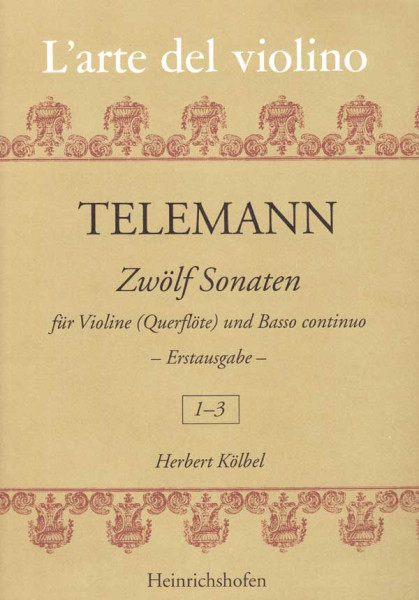
Georg Philipp Telemann
Twelve sonatas | sonatas 1 - 3 | volume 1 Violin ( flute) and basso continuo
First edition This edition is based on a manuscript from the Staatsbibliothek Berlin, Preußischer Kulturbesitz, Musikabteilung. It comes from the estate of Telemann, who gave it to his grandson Georg Michael Telemann (1748-1831). G. Poelchau acquired the manuscript in 1834 with a pack of music stored in a church tower in Riga. From Poelchau's estate († 1836) the sonata work came to the Royal Library in Berlin. The sonatas are dedicated to the brothers Rudolf, Hieronymus and Johannes Wilhelm Burmester of a Hamburg patrician family dated 1 March 1734, with the note that they follow the ‘12 methodical sonatas’, which were also dedicated to the first two brothers. The close connection between the two large sonata works can be found in their valuable musical content, in the sequence of movements (slow, fast, slow, fast), and in the succession of keys (C-a-D-h-E-F-d-G-e-A-f sharp-g). The bass lines are often involved in the theme. Occasionally we are reminded of J.S. Bach's inventions. In the title, the violin is named as the solo instrument before the flute, as several sonatas are unmistakably written “violinistically” without this hindering their playability for flute. The present edition adheres strictly to the manuscript. Suggestions for dynamics are indicated as such by brackets, as are those for articulation (by dotted lines), which may differ for violinists from those intended for flute. Experienced players should use the original figured bass for their own interpretation. The 12 sonatas made available to the public here for the first time are among the best compositions of this kind by Telemann, who dedicated them to 'connoisseurs and lovers' with the wish '...faire une bonne partie de Vos amusements'. The sonatas will fulfill this purpose today just as they did at that time.
Mehr €27.50 *
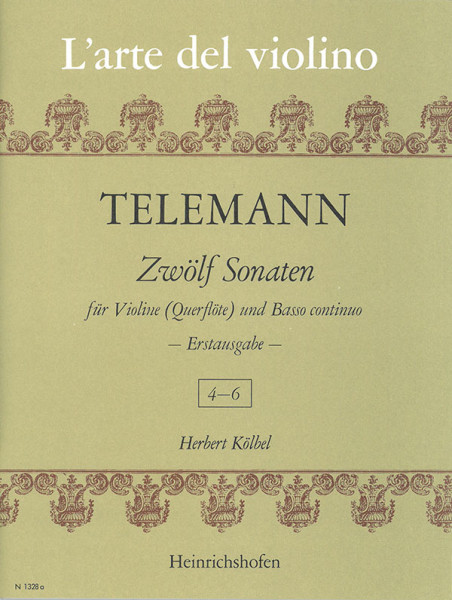
Georg Philipp Telemann
Twelve sonatas | sonatas 4 - 6 | volume 2 Violin (flute) and basso continuo
First edition This edition is based on a manuscript from the Staatsbibliothek Berlin, Preußischer Kulturbesitz, Musikabteilung. It comes from the estate of Telemann, who gave it to his grandson Georg Michael Telemann (1748-1831). G. Poelchau acquired the manuscript in 1834 with a pack of music stored in a church tower in Riga. From Poelchau's estate († 1836) the sonata work came to the Royal Library in Berlin. The sonatas are dedicated to the brothers of a Hamburg patrician family (Rudolf, Hieronymus and Johannes Wilhelm Burmester) dated 1 March 1734, with the note that they follow the ‘12 methodical sonatas’, which were also dedicated to the first two brothers. The close connection between the two large sonata works can be found in their valuable musical content, in the sequence of movements (slow, fast, slow, fast), and in the succession of keys (C-a-D-h-E-F-d-G-e-A-f sharp-g). The bass lines are often involved in the theme. Occasionally we are reminded of J.S. Bach's inventions. In the title, the violin is named as the solo instrument before the flute, as several sonatas are unmistakably written “violinistically” without this hindering their playability for flute. The present edition adheres strictly to the manuscript. Suggestions for dynamics are indicated as such by brackets, as are those for articulation (by dotted lines), which may differ for violinists from those intended for flute. Experienced players should use the original figured bass for their own interpretation. The 12 sonatas made available to the public here for the first time are among the best compositions of this kind by Telemann, who dedicated them to ' connoisseurs and lovers' with the wish '. ..faire une bonne partie de Vos amusements' . The sonatas will fulfill this purpose today just as they did at that time. Content: IV. Largo Allegro Andante Vivace V. Largo Allegro Grave Vivace VI. Andante Presto Cantabile Vivace
Mehr €27.50 *
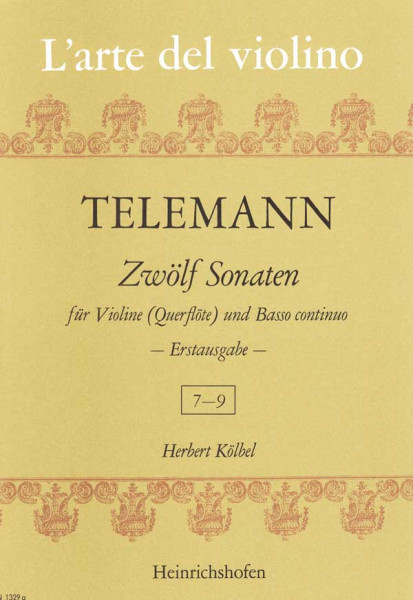
Georg Philipp Telemann
Twelve sonatas | sonatas 7 - 9 | volume 3 Violin (flute) and Basso continuo
First edition This edition is based on a manuscript from the Staatsbibliothek Berlin, Preußischer Kulturbesitz, Musikabteilung. It comes from the estate of Telemann, who gave it to his grandson Georg Michael Telemann (1748-1831). G. Poelchau acquired the manuscript in 1834 with a pack of music stored in a church tower in Riga. From Poelchau's estate († 1836) the sonata work came to the Royal Library in Berlin. The sonatas are dedicated to the brothers Rudolf, Hieronymus and Johannes Wilhelm Burmester of a Hamburg patrician family dated 1 March 1734, with the note that they follow the ‘12 methodical sonatas’, which were also dedicated to the first two brothers. The close connection between the two large sonata works can be found in their valuable musical content, in the sequence of movements (slow, fast, slow, fast), and in the succession of keys (C-a-D-h-E-F-d-G-e-A-f sharp-g). The bass lines are often involved in the theme. Occasionally we are reminded of J.S. Bach's inventions. In the title, the violin is named as the solo instrument before the flute, as several sonatas are unmistakably written “violinistically” without this hindering their playability for flute. The present edition adheres strictly to the manuscript. Suggestions for dynamics are indicated as such by brackets, as are those for articulation (by dotted lines), which may differ for violinists from those intended for flute. Experienced players should use the original figured bass for their own interpretation. The 12 sonatas made available to the public here for the first time are among the best compositions of this kind by Telemann, who dedicated them to 'connoisseurs and lovers' with the wish '...faire une bonne partie de Vos amusements'. The sonatas will fulfill this purpose today just as they did at that time.
Mehr €27.50 *
Viewed
